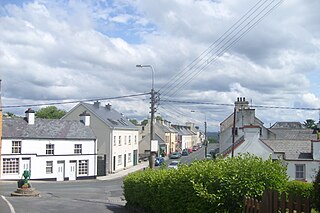
Larne is a town on the east coast of County Antrim, Northern Ireland, with a population of 18,755 at the 2011 Census. It is a major passenger and freight roll-on roll-off port. Larne is administered by Mid and East Antrim Borough Council. Together with parts of the neighbouring districts of Antrim and Newtownabbey and Causeway Coast and Glens, it forms the East Antrim constituency for elections to the Westminster Parliament and Northern Ireland Assembly. The civil parish is in the historic barony of Glenarm Upper.

Mountcharles is a village and townland in the south of County Donegal, Ireland. It lies 6 km from Donegal Town on the Killybegs road (N56). It is situated in the civil parish of Inver and the historic barony of Banagh. The village's name is usually pronounced locally as 'Mount-char-liss'.

Drumbeg is a small village, townland and civil parish on the south bank of the River Lagan in County Down, Northern Ireland. The village is covered by the Lisburn City Council area and forms part of the suburban fringe of Belfast.

Upper Ballinderry is a small village to the east of Lower Ballinderry in County Antrim, Northern Ireland. It is within the townland of Ballyscolly and civil parish of Ballinderry, the historic barony of Massereene Upper. Upper Ballinderry is about 10 miles (15 km) north- west of Lisburn. In the 2001 Census it had a population of 192 people.
Killoe is a rural community and parish in County Longford, Ireland, located approximately 6 miles north of Longford Town. It is home to Cairn Hill or Carn Clonhugh - the highest peak in County Longford.

Killyman is a small village and a civil parish in Northern Ireland, situated on the eastern boundary of County Tyrone and extending into County Armagh. The majority of townlands are in the historic barony of Dungannon Middle in County Tyrone, the rest being in the barony of Oneilland West in County Armagh.
Drumrainy is a townland of 231 acres in County Donegal, Ireland, 4 km from the village of Dunkineely. It is situated in the civil parish of Inver and the historic barony of Banagh.
Glebe is an area of land within an ecclesiastical parish used to support a parish priest.

Ardcarn or Ardcarne, is a civil parish in County Roscommon, Ireland.

Leitir Mhic an Bhaird or Leitir Mhic a' Bhaird is a Gaeltacht village in the Rosses region of County Donegal, Ireland. The village, known colloquially as Leitir, is between the larger towns of Glenties and Dungloe. It is also a civil parish in the historic barony of Boylagh.

Banagh is a historic barony in County Donegal in Ireland. Patrick Weston Joyce said the name Banagh came from Enna Bogaine, son of Conall Gulban, son of Niall of the Nine Hostages. It was created along with Boylagh when the former barony of Boylagh and Banagh was split in 1791 by an Act of the Parliament of Ireland.

Brickens, officially Brickeens, is a village and townland on the N60 road between Ballyhaunis and Claremorris in southeast County Mayo in Ireland. The River Robe flows through the village which is 65 metres above sea level, and old ordnance survey maps show the townland with an area of 368 acres and 23 perches – equivalent to nearly 150 hectares.
The civil parish of Kilcommon in Erris, northern County Mayo, Ireland has a total of 37 townlands: small geographic divisions of land in Ireland and Scotland's Outer Hebrides. Townlands originated in Gaelic Ireland, and predate the late-12th-century Anglo-Norman invasion. However, some townland names are derived from British plantations and Norman manors.
Kiltenanlea or Kiltonanlea is a civil parish in County Clare, Ireland.
Tickmacrevan is a civil parish in County Antrim, Northern Ireland. It is situated in the historic barony of Glenarm Lower.
Leny is a civil parish in County Westmeath, Ireland. It is located about 10.5 kilometres (7 mi) north–west of Mullingar. This name also applies to the townland of Leny; neither should be confused with the Falls of Leny in Scotland.
Mayne, is a civil parish in County Westmeath, Ireland. It is located about 18.03 kilometres (11 mi) north of Mullingar.
Clonsilla or "Clonsillagh" is a civil parish and a townland located in the south-western corner of the modern county of Fingal, Ireland. The civil parish is part of the ancient barony of Castleknock. It is centred on the suburban village of Clonsilla. In geology, the parish rests on a substratum of limestone and comprises 2943 statute acres, the whole of which is arable land. It is roughly bounded to the north by the old "Navan Road" – the modern N3; to the east by the civil parish of Castleknock; to the south by the River Liffey; to the south-east by the civil parish of Leixlip, chiefly in County Kildare, and to the north-west by the civil parish of Dunboyne in County Meath.
Donacavey, sometimes spelt Donaghcavey, is a townland, civil parish and ecclesiastical parish in County Tyrone, Northern Ireland. The civil parish is split between the historic baronies of Clogher and Omagh East, with the townland in the Clogher barony.











